
60 pounder
Encyclopedia
The British
Ordnance BL 60-pounder was a 5 inch (127 mm) heavy field gun
designed in 1903-05 to provide a new capability that had been partially met by the interim QF 4.7 inch Gun
. It was designed for both horse draft and mechanical traction and served throughout the First World War in the main theatres. It remained in service with British and Commonwealth forces in the inter-war period and in frontline service with British and South African batteries until 1942 being superseded by the BL 4.5 inch Medium Gun
.
(1899–1902) was a revelation to armies in Europe including the British. They were impressed by their mobility and range. Britain used some heavy guns in that war under ad hoc arrangements. After the capture of Pretoria in 1900 Lord Roberts, the commander-in-chief in South Africa (and an artillery officer), had stated the requirements of a heavy field gun: a range of 10,000 yards, weight behind the team of no more than 4 tons and the largest possible shell, accordingly the Ordnance Committee in London ordered experimental guns and three were trialled.
However, in 1902 the Heavy Battery Committee was formed comprising officers experienced with heavy and siege artillery in South Africa and presided over by Colonel Perrott who had commanded the Siege Train there. In early 1903 their first report dismissed the 4.7 inch (120 mm, used in South Africa) and the 30 pounder (used in India) from further consideration because they lacked firepower. Of the three trial guns they accepted the Armstrong design but rejected all three carriage designs. New designs were sought that were easier for detachments to use. 1904 trials with a new design, including both horse and mechanised towing, resulted in further changes but in 1905 the design for the BL 60 pounder was accepted, although it was still a half ton over the target weight.
Unfortunately, in 1900 the Secretary of State for War had announced a plan to give ‘Volunteer Position Batteries 4.7 inch guns’, he also extolled the merits of 4.7, (which the army knew to be misleading) and in 1902 and 1903 Parliament voted to equip 60 Volunteer batteries with a 4.7 inch, despite the 60 pounder being in development. The 4.7 inch had many weaknesses as a field equipment, but it had captured the public’s imagination. However, in 1903 a heavy brigade RGA was formed by converting three siege companies and equipping them with 4.7 inch guns. The following year a second brigade was formed from three more RGA companies. These regular army brigades were part of the corps artillery, although their equipment was an expedient.
The 60 pounder gun was used on most fronts during the First World War and replaced the 4.7 inch guns. At the outbreak of war they equipped, with 4 guns, the heavy battery RGA in each infantry division. In 1916 all batteries on the Western Front started being increased to 6 guns. By this time heavy batteries had ceased to be part of each infantry division and batteries became part of what were eventually called Heavy Artillery Groups with several batteries of different types. After the First World War they equipped medium brigades, later regiments.
Initially 60 pounder was fitted with tangent sights on a rocking bar with the range scale graduated to 10,400 yards and 22 degrees, the rear sight had a deflection scale. Before the First World War it was fitted with oscillating (reciprocating) sights, using either the older No 5 sighting telescope (x12 magnification) on Sight Oscillating BL 60 pr Mk I or II, which include a sight clinometer and range scale as well as a deflection drum for the telescope. This was replaced by the No 3 carrier for the No 7 dial sight.
 The original 1904 gun and carriage was designed for the gun barrel and recoil mechanism to be moved rearwards on its carriage (i.e. the breech moved towards the end of the trail) when traveling. This was intended to equalise the weight born by the 2 gun carriage wheels and the 2 wheels of the limber towing the gun, hence minimising the weight born by any single wheel. Its cradle was difficult to make. Mk I carriage had the usual field artillery wooden spoked wheels with iron tyres.
The original 1904 gun and carriage was designed for the gun barrel and recoil mechanism to be moved rearwards on its carriage (i.e. the breech moved towards the end of the trail) when traveling. This was intended to equalise the weight born by the 2 gun carriage wheels and the 2 wheels of the limber towing the gun, hence minimising the weight born by any single wheel. Its cradle was difficult to make. Mk I carriage had the usual field artillery wooden spoked wheels with iron tyres.
In February 1915, wartime manufacturing and maintenance requirements led to a simplification of the barrel construction, as gun Mk I* and Mk I**.
 Wartime manufacturing of the carriage was simplified in Mk II by removing the provision to retract the gun for traveling. This moved most of the weight when traveling away from the limber on to the carriage's own wheels - most weight was on the gun carriage wheels rather than the limber wheels and it was 1 ton heavier. 5 ft (1.5 m) diameter x 1 ft (0.3048 m) wide steel traction engine wheels replaced the wooden wheels to cope with the added weight. The tractor wheels added more weight to be towed, requiring the use of Holt artillery tractors to replace horses. In early 1917 new brakes, a new cradle design and calibrating sights were adopted.
Wartime manufacturing of the carriage was simplified in Mk II by removing the provision to retract the gun for traveling. This moved most of the weight when traveling away from the limber on to the carriage's own wheels - most weight was on the gun carriage wheels rather than the limber wheels and it was 1 ton heavier. 5 ft (1.5 m) diameter x 1 ft (0.3048 m) wide steel traction engine wheels replaced the wooden wheels to cope with the added weight. The tractor wheels added more weight to be towed, requiring the use of Holt artillery tractors to replace horses. In early 1917 new brakes, a new cradle design and calibrating sights were adopted.
requested a return to the lighter Mk I carriage. This was not possible, but retracting the gun back on its carriage for traveling was re-introduced in simplified form by disconnecting the barrel from the recoil system and locking it on the trail in the recoiled position. This reduced the weight by 9 cwt. Wooden spoked wheels were re-introduced. This became the Mk III carriage, or Mk II* for converted Mk II carriages.
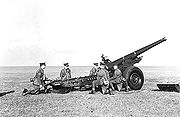 The Mk II gun introduced from 1918 had a longer barrel, new box trail carriage giving increased elevation to 35 degrees and cut-off gear to automatically reduce the recoil length from 54 to 24 inches with increasing elevation, hydro-pneumatic recoil system below the barrel, single-motion Asbury breech. It arrived too late to see service in the First World War and was effectively a new weapon. The gun was one of two types that could be carried by the Gun Carrier Mark I
The Mk II gun introduced from 1918 had a longer barrel, new box trail carriage giving increased elevation to 35 degrees and cut-off gear to automatically reduce the recoil length from 54 to 24 inches with increasing elevation, hydro-pneumatic recoil system below the barrel, single-motion Asbury breech. It arrived too late to see service in the First World War and was effectively a new weapon. The gun was one of two types that could be carried by the Gun Carrier Mark I
.
60 pounder remained unchanged except for carriage modifications to enable mechanisation and new sights. Carriages were first the Mk IVR carriage that had wooden wheels and solid rubber tyres and later the Mk IVP carriage had metal wheels, pneumatic tyres and appropriate brakes. South Africa developed a new carriage of their own design from the Mk 1, this used pneumatic tyred wheels on a two wheel bogie.
Sights were changed the calibrating type, initially to the No 9 carrier for the No 7 dial sight. This carrier had muzzle velocity corrector scale and an elevating arc below the sight mount, the arc was fitted with a choice of range scales depending on the ammunition being used. Subsequently the No 14 carrier was issued, this was a Probert pattern calibrating sight, the range scale plate being double sided, 8 crh shell full charge (13,700 yards) and reduced charge Mk IXC (8,300 yards) on one side. On the other side for the 56 lb shell (15,200 yards).
In the 1930s some carriages were converted to the new 4.5 inch (114 mm) BL ordnance to become BL 4.5 inch Gun Mk 1 on Carriage 60 pr Mark IV and IVP, which then started replacing 60 pounder.
and used mainly for counter-battery fire
(i.e. suppressing or destroying the enemy's artillery). When the First World War began a single 4-gun battery was attached to each infantry division of the BEF as available - initial numbers restricted it to the Regular divisions 1 - 6, others were equipped with the obsolescent QF 4.7 inch Gun. From early 1915, 60 pounder batteries moved from Division to Army control. As more 60 pounders became available the 4.7 inch guns were retired.
It is useful to note that writers such as General Farndale occasionally refer to 60 pounders as "medium" guns, but in the First World War they were officially referred to as heavy guns.
From 30 June 1916 the War Office adopted Major-General Birch's recommendations to increase heavy battery sizes to 6 guns, as more guns with better concentration of firepower were required on the Western Front, while minimising the administrative overhead of more batteries. Batteries in the other minor theatres appear to have mostly retained a 4-gun structure.
In the First World War the Mk I gun could fire the early 60 lb
(27.3 kg) 2 c.r.h. shell 10,300 yd (9.4 km), and the later more streamlined 8 c.r.h. shell to 12300 yards (11,247.1 m). Weighing 4.4 tonne
s, the 60-pounder required a team of 8 horse
s to tow it, with a maximum of 12 possible in difficult conditions. Mechanical towing by Holt Tractor
s and later motor lorries took over from horses towards the end of the First World War.
At the end of the war no batteries were based within the United Kingdom, 74 batteries were in service with the BEF on the Western Front, three in Italy, 11 in Macedonia, seven in Palestine, and four in Mespotamia. In addition 2 Canadian batteries were active on the Western Front and were the only other force using the weapon.
During the Second World War they served with the BEF in France and North Africa in medium regiments, by the South African artillery in East Africa and by an Australian battery at Tobruk. Its last combat action was in the Western Desert
. 19 were with the BEF and lost in France and total British holdings were expected to be 134 guns by August 1940, most being reconditioned or repaired guns.
The accompanying photograph in the manual depicts a Mk I gun on Mk II carriage with traction-engine wheels typical of the Mk II carriage, and the accompanying diagram depicts the gun in the forward traveling position (i.e. with weight over the gun carriage) typical of the Mk II carriage mounting.
Subsequently, after the First World War a 56-pound 10 c.r.h. shell to 15,200 yards was introduced. However, its HE content was less than 2/3 that of the various 60 lb shells and it was some 3 inches shorter.
Shrapnel was also varied with bullet weights ranging from 35 to 41 bullets/pound and total loads varying from 616 (Mk ID) to 992 (Mk I) bullets.
Chemical shells were used with 60 pounder but not smoke or incendiary.
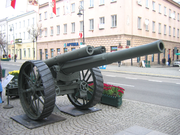
United Kingdom
The United Kingdom of Great Britain and Northern IrelandIn the United Kingdom and Dependencies, other languages have been officially recognised as legitimate autochthonous languages under the European Charter for Regional or Minority Languages...
Ordnance BL 60-pounder was a 5 inch (127 mm) heavy field gun
Field gun
A field gun is an artillery piece. Originally the term referred to smaller guns that could accompany a field army on the march and when in combat could be moved about the battlefield in response to changing circumstances, as to opposed guns installed in a fort, or to siege cannon or mortars which...
designed in 1903-05 to provide a new capability that had been partially met by the interim QF 4.7 inch Gun
QF 4.7 inch Gun Mk I - IV
The QF 4.7 inch Gun Mks I, II, III, and IV were a family of United-Kingdom 120-mm naval and coast defence guns of 1888 and 1890s which served with the navies of various countries. They were also mounted on various wheeled carriages to provide the British Army with a long range gun...
. It was designed for both horse draft and mechanical traction and served throughout the First World War in the main theatres. It remained in service with British and Commonwealth forces in the inter-war period and in frontline service with British and South African batteries until 1942 being superseded by the BL 4.5 inch Medium Gun
BL 4.5 inch Medium Field Gun
The BL 4.5 inch Medium Gun was a British gun used by field artillery in the Second World War. It had nothing in common with the QF 4.5 inch Howitzer or the QF 4.5 inch AA Gun.- History :...
.
Origin and Use
The effective use of modern heavy field guns by the Boers during the Second Boer WarSecond Boer War
The Second Boer War was fought from 11 October 1899 until 31 May 1902 between the British Empire and the Afrikaans-speaking Dutch settlers of two independent Boer republics, the South African Republic and the Orange Free State...
(1899–1902) was a revelation to armies in Europe including the British. They were impressed by their mobility and range. Britain used some heavy guns in that war under ad hoc arrangements. After the capture of Pretoria in 1900 Lord Roberts, the commander-in-chief in South Africa (and an artillery officer), had stated the requirements of a heavy field gun: a range of 10,000 yards, weight behind the team of no more than 4 tons and the largest possible shell, accordingly the Ordnance Committee in London ordered experimental guns and three were trialled.
However, in 1902 the Heavy Battery Committee was formed comprising officers experienced with heavy and siege artillery in South Africa and presided over by Colonel Perrott who had commanded the Siege Train there. In early 1903 their first report dismissed the 4.7 inch (120 mm, used in South Africa) and the 30 pounder (used in India) from further consideration because they lacked firepower. Of the three trial guns they accepted the Armstrong design but rejected all three carriage designs. New designs were sought that were easier for detachments to use. 1904 trials with a new design, including both horse and mechanised towing, resulted in further changes but in 1905 the design for the BL 60 pounder was accepted, although it was still a half ton over the target weight.
Unfortunately, in 1900 the Secretary of State for War had announced a plan to give ‘Volunteer Position Batteries 4.7 inch guns’, he also extolled the merits of 4.7, (which the army knew to be misleading) and in 1902 and 1903 Parliament voted to equip 60 Volunteer batteries with a 4.7 inch, despite the 60 pounder being in development. The 4.7 inch had many weaknesses as a field equipment, but it had captured the public’s imagination. However, in 1903 a heavy brigade RGA was formed by converting three siege companies and equipping them with 4.7 inch guns. The following year a second brigade was formed from three more RGA companies. These regular army brigades were part of the corps artillery, although their equipment was an expedient.
The 60 pounder gun was used on most fronts during the First World War and replaced the 4.7 inch guns. At the outbreak of war they equipped, with 4 guns, the heavy battery RGA in each infantry division. In 1916 all batteries on the Western Front started being increased to 6 guns. By this time heavy batteries had ceased to be part of each infantry division and batteries became part of what were eventually called Heavy Artillery Groups with several batteries of different types. After the First World War they equipped medium brigades, later regiments.
Production
By the outbreak of war in 1914 41 guns had been produced, 13 being in Canada and India. Armstrong were the main supplier, with Vickers and Ordnance Factory Woolwich also producing complete equipments. Major assemblies including barrels were also produced by many other companies. Total wartime production was 1773 guns (i.e. barrels) and 1397 carriages.General Features
60 pounder was a heavy field gun or ‘gun of position’ designed to be towed by either a horse team or mechanical vehicle. It had a quick firing recoil, meaning that the carriage did not move when the gun fired. The barrel was a wire wound A tube in a jacket with a screw breach. It fired a separate round (i.e. shell and bagged cartridge were loaded separately). The lower carriage comprised a box trail. It was designed for one-man laying with both traverse and elevation sights and controls on the left. Recoil system was below the barrel and used a hydraulic buffer with a hydro-pneumatic recuperator to return the barrel to its firing position.Initially 60 pounder was fitted with tangent sights on a rocking bar with the range scale graduated to 10,400 yards and 22 degrees, the rear sight had a deflection scale. Before the First World War it was fitted with oscillating (reciprocating) sights, using either the older No 5 sighting telescope (x12 magnification) on Sight Oscillating BL 60 pr Mk I or II, which include a sight clinometer and range scale as well as a deflection drum for the telescope. This was replaced by the No 3 carrier for the No 7 dial sight.
Mk I gun on Mk I carriage

In February 1915, wartime manufacturing and maintenance requirements led to a simplification of the barrel construction, as gun Mk I* and Mk I**.
Mk I gun on Mk II carriage

Mk I gun on Mk III carriage
The increased weight with the traction engine wheels made maneuvering difficult in typical mud conditions. In June 1916 the BEF commander General HaigDouglas Haig
Douglas Haig, 1st Earl Haig was a British soldier and senior commander during World War I.Douglas Haig may also refer to:* Club Atlético Douglas Haig, a football club from Argentina* Douglas Haig , American actor...
requested a return to the lighter Mk I carriage. This was not possible, but retracting the gun back on its carriage for traveling was re-introduced in simplified form by disconnecting the barrel from the recoil system and locking it on the trail in the recoiled position. This reduced the weight by 9 cwt. Wooden spoked wheels were re-introduced. This became the Mk III carriage, or Mk II* for converted Mk II carriages.
Mk II gun on Mk IV carriage

Gun Carrier Mark I
The Gun Carrier Mark I was the first piece of self-propelled artillery ever to be produced, a British development from the First World War.-Development:...
.
Between The Wars
After the First World War the various types of heavy artillery (including siege) were redesignated medium, heavy and super-heavy and these terms used to describe both the guns and in battery and brigade designations. 60 pounder was officially classed as medium. These terms had been used in various documents in that war but not in the official designations of batteries.60 pounder remained unchanged except for carriage modifications to enable mechanisation and new sights. Carriages were first the Mk IVR carriage that had wooden wheels and solid rubber tyres and later the Mk IVP carriage had metal wheels, pneumatic tyres and appropriate brakes. South Africa developed a new carriage of their own design from the Mk 1, this used pneumatic tyred wheels on a two wheel bogie.
Sights were changed the calibrating type, initially to the No 9 carrier for the No 7 dial sight. This carrier had muzzle velocity corrector scale and an elevating arc below the sight mount, the arc was fitted with a choice of range scales depending on the ammunition being used. Subsequently the No 14 carrier was issued, this was a Probert pattern calibrating sight, the range scale plate being double sided, 8 crh shell full charge (13,700 yards) and reduced charge Mk IXC (8,300 yards) on one side. On the other side for the 56 lb shell (15,200 yards).
In the 1930s some carriages were converted to the new 4.5 inch (114 mm) BL ordnance to become BL 4.5 inch Gun Mk 1 on Carriage 60 pr Mark IV and IVP, which then started replacing 60 pounder.
Second World War
60 pounder was withdrawn from active service in 1941 but remained in training use until 1944. It was replaced by the BL 4.5 inch Gun Mk 2 on Carriage 4.5 inch and 5.5 inch Guns.First World War
The 60-pounder Mk. I were formed into "Heavy Batteries" in the First World War operated by the Royal Garrison ArtilleryRoyal Garrison Artillery
The Royal Garrison Artillery was an arm of the Royal Artillery that was originally tasked with manning the guns of the British Empire's forts and fortresses, including coastal artillery batteries, the heavy gun batteries attached to each infantry division, and the guns of the siege...
and used mainly for counter-battery fire
Counter-battery fire
Counter-battery fire is a type of mission assigned to military artillery forces, which are given the task of locating and firing upon enemy artillery.-Background:...
(i.e. suppressing or destroying the enemy's artillery). When the First World War began a single 4-gun battery was attached to each infantry division of the BEF as available - initial numbers restricted it to the Regular divisions 1 - 6, others were equipped with the obsolescent QF 4.7 inch Gun. From early 1915, 60 pounder batteries moved from Division to Army control. As more 60 pounders became available the 4.7 inch guns were retired.
It is useful to note that writers such as General Farndale occasionally refer to 60 pounders as "medium" guns, but in the First World War they were officially referred to as heavy guns.
From 30 June 1916 the War Office adopted Major-General Birch's recommendations to increase heavy battery sizes to 6 guns, as more guns with better concentration of firepower were required on the Western Front, while minimising the administrative overhead of more batteries. Batteries in the other minor theatres appear to have mostly retained a 4-gun structure.
In the First World War the Mk I gun could fire the early 60 lb
Pound (mass)
The pound or pound-mass is a unit of mass used in the Imperial, United States customary and other systems of measurement...
(27.3 kg) 2 c.r.h. shell 10,300 yd (9.4 km), and the later more streamlined 8 c.r.h. shell to 12300 yards (11,247.1 m). Weighing 4.4 tonne
Tonne
The tonne, known as the metric ton in the US , often put pleonastically as "metric tonne" to avoid confusion with ton, is a metric system unit of mass equal to 1000 kilograms. The tonne is not an International System of Units unit, but is accepted for use with the SI...
s, the 60-pounder required a team of 8 horse
Horse
The horse is one of two extant subspecies of Equus ferus, or the wild horse. It is a single-hooved mammal belonging to the taxonomic family Equidae. The horse has evolved over the past 45 to 55 million years from a small multi-toed creature into the large, single-toed animal of today...
s to tow it, with a maximum of 12 possible in difficult conditions. Mechanical towing by Holt Tractor
Holt tractor
The Holt tractors were a range of caterpillar tractors built by the Holt Manufacturing Company, which was named after Benjamin Holt- Military Use :...
s and later motor lorries took over from horses towards the end of the First World War.
At the end of the war no batteries were based within the United Kingdom, 74 batteries were in service with the BEF on the Western Front, three in Italy, 11 in Macedonia, seven in Palestine, and four in Mespotamia. In addition 2 Canadian batteries were active on the Western Front and were the only other force using the weapon.
After the First World War
60 pounder remained in service during the inter-war period and was used in Russia (1919) Mesopotamia 1920-21.During the Second World War they served with the BEF in France and North Africa in medium regiments, by the South African artillery in East Africa and by an Australian battery at Tobruk. Its last combat action was in the Western Desert
Libyan Desert
The Libyan Desert covers an area of approximately 1,100,000 km2, it extends approximately 1100 km from east to west, and 1,000 km from north to south, in about the shape of a rectangle...
. 19 were with the BEF and lost in France and total British holdings were expected to be 134 guns by August 1940, most being reconditioned or repaired guns.
US Service
USA acquired some 60 pounders, presumably for evaluation, reported in its May 1920 Handbook of Artillery :-
"The United States procured a number of batteries of 5-inch 60 pounder guns with the necessary accompanying vehicles from Great Britain. The materiel is of British design and manufacture throughout, and the units ceded to the United States include the Gun, Mark I, mounted on a carriage, Mark II; the gun carriage limber, Mark II, the ammunition wagon, Mark II; and the ammunition wagon limber, Mark II".
The accompanying photograph in the manual depicts a Mk I gun on Mk II carriage with traction-engine wheels typical of the Mk II carriage, and the accompanying diagram depicts the gun in the forward traveling position (i.e. with weight over the gun carriage) typical of the Mk II carriage mounting.
Ammunition
At the beginning of the First World War 60 pounder ammunition scale was 70% shrapnel and 30% HE. The standard shell was 2 crh, but in 1917 a 8 crh shell was adopted.Subsequently, after the First World War a 56-pound 10 c.r.h. shell to 15,200 yards was introduced. However, its HE content was less than 2/3 that of the various 60 lb shells and it was some 3 inches shorter.
Shrapnel was also varied with bullet weights ranging from 35 to 41 bullets/pound and total loads varying from 616 (Mk ID) to 992 (Mk I) bullets.
Chemical shells were used with 60 pounder but not smoke or incendiary.
World War 1 Ammunition
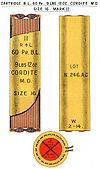 |
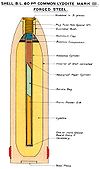 |
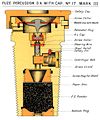 |
 |
 |
 |
 |
 |
Cordite Cordite is a family of smokeless propellants developed and produced in the United Kingdom from 1889 to replace gunpowder as a military propellant. Like gunpowder, cordite is classified as a low explosive because of its slow burning rates and consequently low brisance... cartridge |
Surviving examples

- At the Imperial War MuseumImperial War MuseumImperial War Museum is a British national museum organisation with branches at five locations in England, three of which are in London. The museum was founded during the First World War in 1917 and intended as a record of the war effort and sacrifice of Britain and her Empire...
London - The Central Museum of The Royal Regiment of Canadian Artillery, Shilo Manitoba
- Polish Military Museum, Warsaw
- A Mk I gun at Terrace Park in Springfield, South Dakota, U.S.A.
- http://www.waymarking.com/waymarks/WM6BGA_BL_60_Pounder_5_inch_Gun_Cairo_Illinois Cairo Illinois

